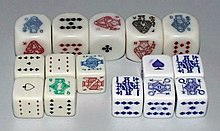| Revision as of 20:11, 31 January 2012 editSMcCandlish (talk | contribs)Autopatrolled, Extended confirmed users, Page movers, File movers, New page reviewers, Pending changes reviewers, Rollbackers, Template editors201,792 edits tweak← Previous edit | Revision as of 20:13, 31 January 2012 edit undoSMcCandlish (talk | contribs)Autopatrolled, Extended confirmed users, Page movers, File movers, New page reviewers, Pending changes reviewers, Rollbackers, Template editors201,792 edits typoNext edit → | ||
| Line 49: | Line 49: | ||
| |} | |} | ||
| Busts are much lower probability than in card poker, because there are only 6 values instead of 13, making pairs and straights much more likely than with cards. In poker dice there are in fact only |
Busts are much lower probability than in card poker, because there are only 6 values instead of 13, making pairs and straights much more likely than with cards. In poker dice there are in fact only four possible bust hands: A K Q J 9, A K Q 10 9, A K J 10 9, and A Q J 10 9; both other no-pair hands (i.e., in which either the A or the 9 are missing) are straights.<!--No source need be cited here; this is elementary arithmetic a small child can work out in a matter of minutes.--> Consequently, in some variants of the rules, straights are counted as busts.<ref name="about">{{cite web |url=http://boardgames.about.com/od/pokerdice/a/rules.htm |title=The Complete Rules for the Dice Game Poker Dice |first=Erik |last=Arneson |year=2012 |work=About.com |at="Board / Card Games" subsite |publisher=New York Times Company}}<!--Normally About.com is not a reliable source for facts about things; it's simply being used as a QED reliable source that some published rulesets have ignored straights, since it has published such a ruleset.--></ref> | ||
| ==See also== | ==See also== | ||
Revision as of 20:13, 31 January 2012


Poker dice are dice which, instead of having number pips, have representations of playing cards upon them. Poker dice have six sides, one each of an Ace, King, Queen, Jack, ten and nine, and are used to form a poker hand.
The classic poker dice game is played with 5 dice and two or more players. Each player has a total of 3 rolls and the ability to hold dice in between rolls. After the three rolls the best hand wins. Neither a "flush" nor a "straight flush" is a possible hand, due to the lack of suits on the dice. (Each variety of poker dice varies slightly in regards to suits, though the ace of spades is almost universally represented. 9♣ and 10♦ are frequently found, while face cards are traditionally represented not by suit but instead by color: green for kings, red for queens and blue for jacks. Manufacturers have not standardized the colors of the face sides.)
Marlboro once marketed a set of octahedral poker dice that included suits; each die had slightly different numberings, ranging from 7 up to ace.
Probabilities
The poker dice hand rankings and the corresponding probabilities of rolling that hand are as follows (not sorted by probability but from highest to lowest ranking):
| Hand | Exact probability | Percentage | 1 in ... | Example |
|---|---|---|---|---|
| Five of a kind | 6 / 7776 | 0.08% | 1296 | J J J J J |
| Four of a kind | 150 / 7776 | 1.93% | 51.8 | 10 10 10 10 A |
| Full house | 300 / 7776 | 3.86% | 25.9 | K K K 9 9 |
| Straight | 240 / 7776 | 3.09% | 32.4 | A K Q J 10 |
| Three of a kind | 1200 / 7776 | 15.43% | 6.5 | 9 9 9 K J |
| Two pair | 1800 / 7776 | 23.15% | 4.3 | Q Q 9 9 A |
| One pair | 3600 / 7776 | 46.30% | 2.2 | 10 10 K Q 9 |
| Bust (High card, no pair, no straight) | 480 / 7776 | 6.17% | 16.2 | A K Q J 9 |
Busts are much lower probability than in card poker, because there are only 6 values instead of 13, making pairs and straights much more likely than with cards. In poker dice there are in fact only four possible bust hands: A K Q J 9, A K Q 10 9, A K J 10 9, and A Q J 10 9; both other no-pair hands (i.e., in which either the A or the 9 are missing) are straights. Consequently, in some variants of the rules, straights are counted as busts.
See also
References
- Deep, Ronald (2006), Probability and statistics with integrated software routines, Elsevier Inc., ISBN 0-12-369463-9, Chapter 1 p 42
- Bărboianu, Cătălin (2006), Probability Guide to Gambling: The Mathematics of Dice, Slots, Roulette, Baccarat, Blackjack, Poker, Lottery and Sport Bets, INFAROM Publishing, p. 224, ISBN 9-73-875203-5, Extract of page 224
- Arneson, Erik (2012). "The Complete Rules for the Dice Game Poker Dice". About.com. New York Times Company. "Board / Card Games" subsite.
External links
This dice game-related article is a stub. You can help Misplaced Pages by expanding it. |
This poker-related article is a stub. You can help Misplaced Pages by expanding it. |